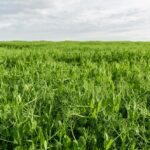Pear scab is a fungal disease that affects pear trees, causing cosmetic damage to the fruit and reducing its quality. Here are some symptoms of pear scab to look out for:
- Scab lesions: The most characteristic symptom of pear scab is the presence of dark, scaly lesions on the surface of the fruit. These lesions may start as small, olive-green or brown spots, and as they grow, they become darker and more scaly.
- Cracked skin: The affected areas of the fruit may develop cracks or fissures as the scab lesions enlarge. The cracks can penetrate deep into the flesh of the pear, making it susceptible to secondary infections or rot.
- Deformed fruit: Pear scab can cause the fruit to become misshapen or distorted. The affected pears may be smaller than usual or have an irregular shape due to the damage caused by the scab lesions.
- Leaf symptoms: In addition to affecting the fruit, pear scab can also cause symptoms on the leaves of the tree. Look for olive-green to black lesions on the upper surface of the leaves. These lesions may be circular or irregular in shape and can cause leaf distortion or defoliation.
- Twig and branch infections: In severe cases, pear scab can infect the twigs and branches of the pear tree. Look for black lesions or cankers on the branches, which may cause dieback or stunted growth.
It’s important to note that other diseases or environmental factors can cause similar symptoms on pears. To confirm the presence of pear scab, it’s best to consult with a local agricultural extension service or a professional horticulturist who can provide accurate diagnosis and recommend appropriate treatments.
Join 'Farmers Mag' WhatsApp Channel
Get the latest Farming news and tips delivered straight to your WhatsApp
CLICK HERE TO JOIN






